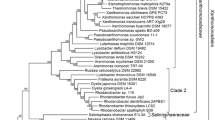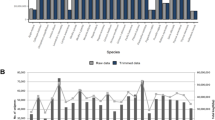Abstract
Laminaria and Saccharina have recently been recognized as two independent clades from the former genus Laminaria. Traditional morphological taxonomy is being challenged by molecular evidence from both nucleus and plastid. Intensive work is in great demand from the perspective of genome colinearity. In this study, 118 sequence-tagged site (STS) markers were screened for phylogenetic analyses, 29 based on genome sequences, while 89 were based on expressed sequence tag (EST) sequences. EST-based STS marker development (29.37%) had an effi ciency twice as high as genome-sequence-based development (9.48%) as a result of high conservation of gene transcripts among the relative species. S. ochotensis, S. religiosa, S. japonica, and L. hyperborea showed great homogeneity in all 118 STS markers. Our result supports the view that the diversifi cation between the genera Saccharina and Laminaria was a more recent event and that Saccharina and Laminaria shared high phylogenetic affi nity. However, when it came to the single nucleotide polymorphism (SNP) level among the 41 SNPs, L. hyperborea owned 29 unique SNPs against 12 within the left three Saccharina species and 12 of the 13 indels were supposedly unique for L. hyperborea, indicated by its high variability. Originating from homologous ancestors, species between the recently diverged genera Laminaria and Saccharina may have taken in enough mutations at the SNP level only, in spite of different evolutionary strategies for better adaptation to the environment. Our study lays a solid foundation from a new perspective, although more accurate phylogenetic analysis is still needed to clarify the evolutionary traces between the genera Saccharina and Laminaria.
Similar content being viewed by others
References
Altshuler D, Pollara V J, Cowles C R, Etten W J V, Baldwin J, Linton L, Lander E S. 2000. An SNP map of the human genome generated by reduced representation shotgun sequencing. Nature, 407: 513–516.
Bartsch I, Wiencke C, Bischof K, Buchholz C M, Buck B H, Eggert A, Feuerpfeil P, Hanelt D, Jacobsen S, Karez R, Karsten U, Molis M, Roleda M Y, Schubert H, Schumann R, Valentin K, Weinberger F, Wiese J. 2008. The genus Laminaria sensu lato: recent insights and developments. European Journal of Phycology, 43(1): 1–86.
Bolton J J, Germann I, Luning K. 1983. Hybridization between Atlantic and Pacifi c representatives of the Simplices section of Laminaria (Phaeophyta). Phycologia, 22(2): 133–140.
Clark D L. 1971. Arctic Ocean ice cover and its late Cenozoic history. Geological Society of America Bulletin, 82(12): 3 313–3 324.
Druehl L D. 1970. The pattern of Laminariales distribution in the northeast Pacifi c. Phycologia, 9(3 and 4): 237–247.
Durham J W. 1950. Cenozoic marine climates of the Pacifi c coast. Geological Society of America Bulletin, 61(11): 1 243–1 264.
Estes J A, Steinberg P D. 1988. Predation, herbivory, and kelp evolution. Paleobiology, 14(1): 19–36.
Fan J B, Oliphant A, Shen R, Kermani B G, Garcia F, Gunderson K L, Hansen M, Steemers F, Butler S L, Deloukas P, Galver L, Hunt S, Mcbride C, Bibikova M, Rubano T, Chen J, Wickham E, Doucet D, Chang W, Campbell D, Zhang B, Kruglyak S, Bentley D, Haas J, Rigault P, Zhou L, Stuelpnagel J, Chee M S. 2003. Highly parallel SNP genotyping. Cold Spring Harbor Symposia on Quantitative Biology, 68: 69–78.
Green E D, Green P. 1991. Sequence-tagged site (STS) content mapping of human chromosomes: theoretical considerations and early experiences. Genome Research, 1: 77–90.
Guillemaut P, Drouard L M. 1992. Isolation of plant DNA: a fast inexpensive and reliable method. Plant Molecular Biology Report, 10(1): 60–65.
Jablonski D, Sepkoski J J. 1996. Paleobiology, community ecology, and scales of ecological pattern. Ecology, 77(5): 1 367–1 378.
Kain J M. 1967. Populations of Laminaria hyperborea at various latitudes. Helgoländer Wissenschaftliche Meeresuntersuchungen, 15(1-4): 489–499.
Kain J M. 1979. A view on the genus Laminaria. Oceanographic Marine Biology Annual Review, 17: 101–161.
Lane C E, Mayes C, Druehl L D, Saunders G W. 2006. A multigene molecular investigation of the kelp (Laminariales, Phaeophyceae) supports substantial taxonomic reorganization. Journal of Phycology, 42(4): 493–512.
Larkum A W D. 1972. Frond structure and growth in Laminaria hyperborea. Journal of the Marine Biological Association of the United Kingdom, 52(2): 405–418.
LaRota M, Sorrells M E. 2004. Comparative DNA sequence analysis of mapped wheat ESTs reveals the complexity of genome relationships between wheat and rice. Functional & Integrative Genomics, 4(1): 34–46.
Luyend Y K, Forsyth B P D, Phillips J D. 1972. Experimental approach to the palecirculation of the oceanic surface waters. Geological Society of America Bulletin, 83(9): 2 649–2 664.
Naji A M, Moghaddam M, Ghaffari M R, Irandoost H P, Farsad L K, Pirseyedi S M, Mohammadi S A, Ghareyazie B, Mardi M. 2008. Validation of EST-derived STS markers localized on Qfhs.ndsu-3BS for Fusarium head blight resistance in wheat using a ‘Wangshuibai’ derived population. Journal of Genetics and Genomics, 35(10): 625–629.
Olson M, Hood L, Cantor C, Botstein D. 1989. A common language for physical mapping of the human genome. Science, 245(4925): 1 434–1 435.
Oudot-Le S M-P, Klogreg B, Loiseaux-De G S. 2002. The mitochondrial genome of the brown alga Laminaria digitata: a comparative analysis. European Journal of Phycology, 37(2): 163–172.
Phillips N, Burrowes R, Rousseau F, Reviers B, Saunders G W. 2008. Resolving evolutionary relationships among the brown algae using chloroplast and nuclear genes. Journal of Phycology, 44(2): 394–405.
Sanchez A C, Brar D S, Huang N, Li Z, Khush G S. Sequence tagged site marker-assisted selection for three bacterial blight resistance genes in rice. Crop Science, 40: 792–797.
Silberfeld T, Leigh J W, Verbruggen H, Cruaud C, Reviers B, Rousseau F. 2010. A multi-locus time-calibrated phylogeny of the brown algae (Heterokonta, Ochrophyta, Phaeophyceae): investigating the evolutionary nature of the “brown algal crown radiation”. Molecular Phylogenetics and Evolution, 56(2): 659–674.
Tacares E S, Backer A J. 2008. Single mitochondrial gene barcodes reliably identify sister-species in diverse clades of birds. BMC Evolutionary Biology, 8: 81.
Tamura K, Peterson D, Peterson N, Stecher G, Nei M, Kumar S. 2011. MEGA5: molecular evolutionary genetics analysis using maximum likelihood, evolutionary distance, and maximum parsimony methods. Molecular Biology and Evolution, 28(10): 2 731–2 739.
Varshney R K, Sigmund F, Borner A, Korzun V, Stein N, Sorrells M E, Langridge P, Graner A. 2005. Interspecifi c transferability and comparative mapping of barley ESTSSR markers in wheat, rye and rice. Plant Science, 168(1): 195–202.
Wang G L, Tan X L, Shen J L, Li J, Zhang L, Sun J W, Wang B, Weng M L, Liu T. 2011. Development of EST-SSR primers and their practicability test for Laminaria. Acta Oceanologica Sinica, 30(3): 1–6.
Yoon H S, Lee J Y, Boo S M, Debashish B. 2001. Phylogeny of Alariceae, Laminariaceae, and Lessoniaceae (Phaeophyceae) based on plastid-encoded RuBisCo spacer and nuclear-encoded ITS sequence comparisons. Molecular Phylogenetics and Evolution, 21(2): 231–243.
Yotsukura N, Shimizu T, Katayama T, Druehl L D. 2010. Mitochondrial DNA sequence variation of four Saccharina species (Laminariales, Phaeophyceae) growing in Japan. Journal of Applied Phycology, 22(3): 243–251.
Zhang J, Li N, Zhang Z F, Liu T. 2011. Structure analysis of the complete mitochondrial genome in cultivation variety ‘Rongfu’. Journal of Ocean University of China, 10(4): 351–356.
Zhang J, Wang X M, Liu C, Jin Y M, Liu T. 2013. The complete mitochondrial genomes of two brown algae (Laminariales, Pharophyceae) and phylogenetic analysis within Laminaria. Journal of Applied Phycology, 25(4): 1 247–1 253, http://dx.doi.org/10.1007/s10811-012-9915-0.
Author information
Authors and Affiliations
Corresponding author
Additional information
Supported by the National High Technology Research and Development Program of China (863 Program) (No. 2012AA10A406), the Science and Technology Development Project of Shandong Province, China (No. 2006GG3205001), the National Basic Scientifi c Special Fund of the Ministry of Science and Technology, China (No. 2007FY210500), the National Public Benefi t Research Foundation of the State Bureau of Oceanography, China (No. 200805075), and the Research Fund for Basic Sciences of Higher Education by National Ministry of Finance and Education, China (No. 201262003)
Rights and permissions
About this article
Cite this article
Qu, J., Zhang, J., Wang, X. et al. Phylogeny of Saccharina and Laminaria (Laminariaceae, Laminariales, Phaeophyta) in sequence-tagged-site markers. Chin. J. Ocean. Limnol. 32, 22–33 (2014). https://doi.org/10.1007/s00343-014-3134-2
Received:
Accepted:
Published:
Issue Date:
DOI: https://doi.org/10.1007/s00343-014-3134-2




